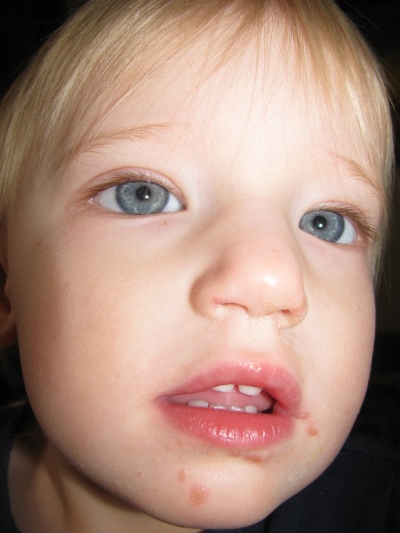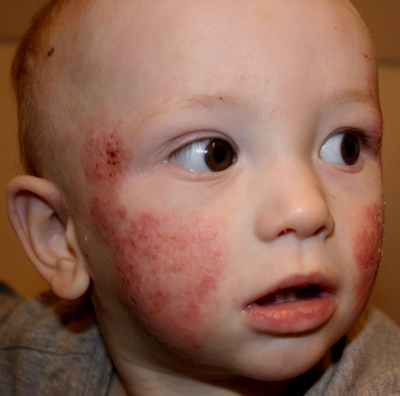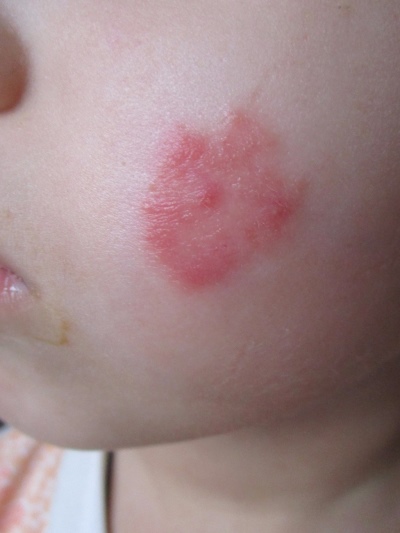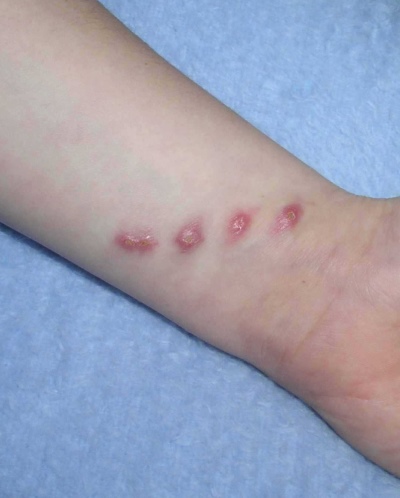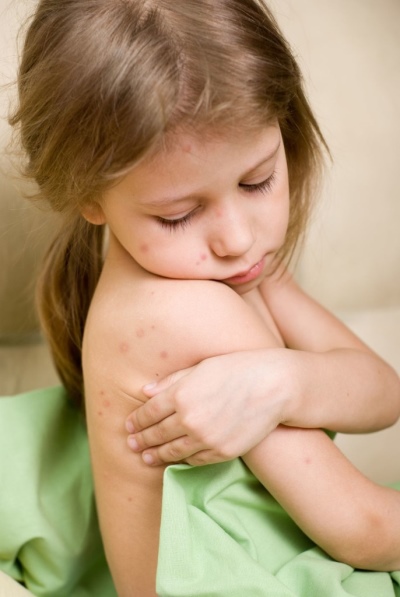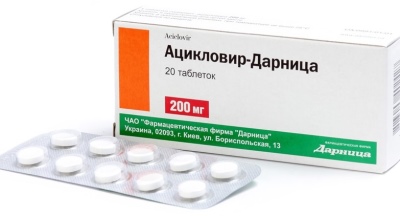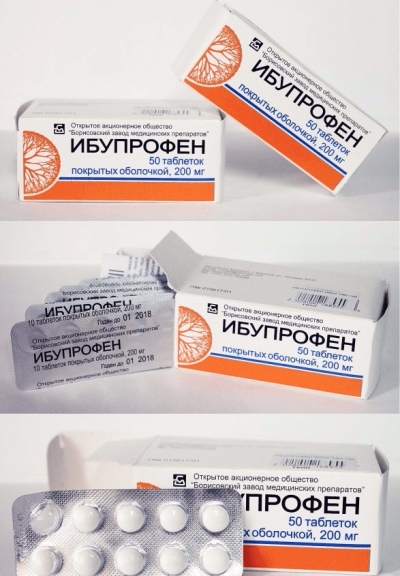What does herpes look like in children?
Herpes - A common viral disease. According to various estimates, one or another type of this infection is present in 95-98% of the population of our planet. There is nothing surprising in the fact that a child has contracted herpes virus. The main thing is to recognize the infection in time and provide the necessary help to the baby.
About the pathogen
Herpes can be very dangerous for newborns and babies. At an older age, when the immunity is more perfect, it is much easier for the child to transfer the disease without complications. A virus infects a person once in a lifetime. After the acute stage of the disease, it is stored in the body in a latent (“sleeping”) state.
As long as the immunity works well, herpes virus will not be felt in any way. But if a child-carrier catches a cold, overcools or overheats in the sun, gets sick with something, then its immunity will become temporarily weaker, and herpes will receive excellent conditions for "awakening" and activation. Herpes viruses cannot be cured, exterminated to the end, you can only ease and alleviate the symptoms of the acute stage. In the latent period, the virus does not cause the child any trouble.
Doctors distinguish 8 types of herpes virus. The first is the herpes simplex virus, it affects only the lips and skin in the nasolabial triangle area. The virus of the second type is genital. The third herpes virus is a varicella zoster virus. The fourth type of herpes is an Epstein-Barr virus that causes infectious mononucleosis. The fifth type is cytomegalovirus.
The sixth herpes virus causes multiple sclerosis in adults and pediatric roseola in children. The seventh and eighth types have not been studied enough, but doctors have reason to believe that they become the cause of such malignant tumors as sarcoma and lymphoma.
Symptoms
You can recognize a herpetic infection by a characteristic watery rash, which at first looks like the appearance of individual vesicles, and then they combine into a single plaque. After a few days the rash bursts, the fluid flows out, a crust forms, which gradually dries out.
Almost all types of herpes viruses cause in the acute stage a rise in temperature (it can reach up to 39.0 - 40.0 degrees), symptoms of intoxication. The child experiences discomfort associated with muscle and joint pain.
Herpes is the most contagious in the acute stage. After the vesicles burst, the child does not pose a great danger to others.
Parents can tell a lot about the appearance of the rash.
- Herpes on the lip or chin (sometimes on the nose) - this is herpes simplex, which is considered the most common. With him, the area of damage can be different - from a small fragment to impressive plaques. It usually begins as ARVI - with a rise in temperature, however, this symptom is not mandatory. Almost always in the place where vesicles appear, in a few hours there is a sensation of itching, tingling. Sometimes, herpes dermatitis is caused by the first or second type of virus, which is most dangerous for children, as in infants, for example, it can cause not only skin lesions, but also herpes vesicular affection of internal organs and the nervous system.
- Genital herpes almost always accompanied by fever, pain in the rash. These are the genitals, the area of the anus, sometimes rashes extend to the buttocks, more precisely, their lower part.Rarely, but this type of herpes can affect the lips, but at the same time, as a rule, the rash is duplicated by the same fragments of a watery rash in the genital area.
- With chickenpox, when infection occurs with a third type of herpes virusIt is the rash that allows the diagnosis to be made correctly. It appears swiftly, with every hour more and more new vesicles are fixed. Rashes are pink spots on the body, which quickly turn into watery with a slight pink edging. Vesicles burst for about 3-4 days, crust disappears in about 2-3 weeks. A rash appears everywhere - on the face, arms and legs, on the stomach, back, in the scalp.
- After the disease produces a stable lifetime immunity.However, in the dormant state, the third herpesvirus under favorable conditions (with a decrease in immunity) can become the cause of herpes zoster. According to statistics, about 20% of people who had recovered from chickenpox subsequently encounter the development of herpes zoster. The rash at the same time affects only one part of the body, has the appearance of a strip, tape. In half of all cases, it is located in the chest and back. Every fifth - on the cheek, head. Rarely strips of rash are located on the neck and lower back.
- Type 4 Herpescausing infectious mononucleosis, rash will manifest itself only 4-5 days after the onset of the disease. Up to this point, the baby will have fairly universal respiratory and general symptoms - fever, enlarged submandibular lymph nodes, redness in the throat, the appearance of filmy plaque on the tonsils. The rash can be quite diverse, it is located on any part of the body, but more often on the hands, including the palms, and on the face.
- With the defeat of herpes type five rash appears rarely, only in case of development of cytomegalovirus infection. The rash is mild, usually it does not have a bright color. The disease proceeds, like other herpetic infections, with fever and lymph nodes, but it has its own characteristic signs - joints are often affected, problems with the urinary system, which parents attribute to cystitis, can be observed.
- Herpes type 6 beginsas an acute respiratory viral disease - with fever. The rash appears only after 4-5 days after the onset of fever. Pediatric roseola (or sudden exanthema) is most often observed in children under 2 years of age. At older age, this disease is much less common. The rash can be located anywhere on the body, it has a characteristic pink color. It is noteworthy that the rash appears always within a day after the baby has decreased and the body temperature normalizes. She passes independently in 7-8 days.
- Herpes type 7 and 8 are rarely accompanied by a rash.his symptoms are sluggish in nature - for a long time (up to six months) he has a fever, the child gets tired faster, remembers badly, sleeps poorly, his lymph nodes often increase. Among the malignant tumors that can be caused by these herpes viruses are Kaposi's sarcoma, primary lymphoma.
- Herpangina, which can cause several types of herpes viruses, is manifested by the appearance of a characteristic rash on the glands, in the oral cavity, as well as a yellowish coating on the tongue, the inner surface of the cheeks, on the tonsils. This type of sore throat is treated hard and for quite a long time. Often there are complications associated with the spread of herpes from the throat to the internal organs.
Treatment
The most effective drug for virtually all herpes viruses is considered "Acyclovir". It is in the form of a cream, ointment, and also comes in tablets and solution for injection.Herpes simplex is usually treated locally, if the doctor has reason to believe that the disease is prolonged or severe, he can hospitalize the child and prescribe "Acyclovir" intravenously.
Some infections, such as genital herpes, cytomegalovirus infection may require not only external use of the drug, but also ingestion in the form of tablets.
In the acute stage, the child needs to have symptomatic treatment - reduce fever if the temperature is above 38.5 degrees (in infants above 38.0), put the child to bed, provide plenty of warm drink. Be sure to isolate the baby from other children, to allocate him a separate dish, linen, towel.
Antipyretics are best used on the basis of paracetamol. If the drug helps for a short time and the fever returns, it is advisable to alternate the use of paracetamol with another antipyretic, for example, Ibuprofen. This nonsteroidal anti-inflammatory drug is produced in the form of tablets in the shell, if there is a need to give medicine to a child up to a year, it is necessary to break off the desired part of the tablet, crush into powder and add water or compote to a teaspoon.
After recovery, it is important for the child to maintain a state of immunity in order to avoid relapses. To do this, parents must provide him with a balanced proper nutrition, rich in vitamins, long walks in the fresh air, sports, hardening. In due time it is necessary to do all vaccinations according to age. These measures will not allow the herpes virus to exit the latent stage.
How the first symptoms of the disease appear herpes and about his treatment methods, see the next video.


